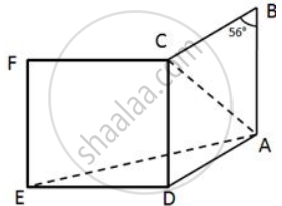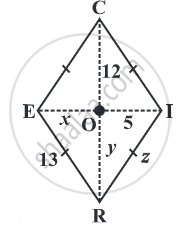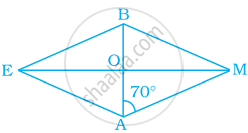Advertisements
Advertisements
Question
In the following figure, ABCD is a rhombus and DCFE is a square.
If ∠ABC =56°, find:
(i) ∠DAE
(ii) ∠FEA
(iii) ∠EAC
(iv) ∠AEC
Solution
ABCD is a rhombus.
⇒ AD = CD and ∠ADC = ∠ABC = 56°
DCFE is a square.
⇒ ED = CD and ∠FED = ∠EDC = ∠DCF = ∠CFE = 90°
⇒ AD = CD = ED
In ΔADE,
AD = ED
⇒ ∠DAE = ∠AED ...(i)
∠DAE + ∠AED + ∠ADE = 180°
⇒ 2∠DAE + 146° = 180° ....( Since ∠ADE = ∠EDC + ∠ADC = 90° + 56° = 146° )
⇒ 2∠DAE = 34°
⇒ ∠DAE = 17°
⇒ ∠DEA = 17° ....(ii)
In ABCD,
∠ABC + ∠BCD + ∠ADC + ∠DAB = 360°
⇒ 56° + 56° + 2 ∠DAB = 360° ....( ∵ Opposite angles of a rhombus are equal.)
⇒ 2∠DAB = 248°
⇒ ∠DAB = 124°
We know that diagonals of a rhombus, bisect its angles.
⇒ ∠DAC = `(124°)/2` = 62°
⇒ ∠EAC = ∠DAC - ∠DAE = 62° - 17° = 45°
Now,
∠FEA = ∠FED - ∠DEA
= 90° - 17° ....( From(ii) and each angle of a square is 90° )
= 73°
We know that diagonals of a square bisect its angles.
⇒ ∠CED = `(90°)/2` = 45°
So,
∠AEC = ∠CED - ∠DEA
= 45° - 17°
= 28°
Hence, ∠DAE = 17°, ∠FEA = 73°, ∠EAC = 45° and ∠AEC = 28°.
APPEARS IN
RELATED QUESTIONS
Prove that the quadrilateral formed by joining the mid-points of consecutive sides of a rectangle is a rhombus.
Prove that the quadrilateral formed by joining the mid-points of consecutive sides of a rhombus is a rectangle.
Prove that if the diagonals of a quadrilateral bisect each other at right angles then it is a rhombus.
Prove that the area of a rhombus is equal to half the rectangle contained by its diagonals.

Diagonals of a rhombus are equal and perpendicular to each other.
A rhombus can be constructed uniquely if both diagonals are given.
The diagonals of a rhombus are 8 cm and 15 cm. Find its side.
In rhombus BEAM, find ∠AME and ∠AEM.

